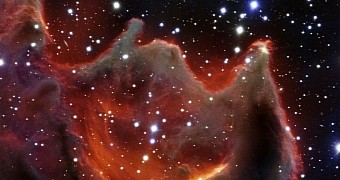Just yesterday, astronomers with the European Southern Observatory released an insanely cool space image detailing the anatomy of a cometary globule dubbed CG4. Yes, we're actually going to go with the word combination “insanely cool.” Trust us, no other would do this image justice.
The cometary globule is located at a distance of about 1,300 light-years from our planet, in the constellation of Puppis. The latest European Southern Observatory image of it, available next to this article, was obtained with the help of the Very Large Telescope in Chile's Atacama Desert.
What the heck is a cometary globule anyway?
Contrary to what some might rightfully assume, given their official designation, cometary globules have nothing to do with comets. True, they kind of, sort of resemble such celestial bodies as far as looks go, but they have a unique anatomy and a distinct list of cosmic ingredients that comprise them.
Thus, astronomers say that cometary globules are essentially small clouds of cosmic gas and dust that have somehow come to be elongated and that, therefore, appear comet-like when observed with the help of telescopes. These clouds that look like comets have dark, dense heads and long, faint Tails.
By the looks of it, the first such peculiar cosmic clouds were observed back in 1976. They were imaged with the UK Schmidt Telescope in Australia, and because of their odd appearance, they ended up being referred to as cometary globules. For some reason, this moniker stuck.
For the time being, scientists cannot say for sure how and why cometary globules form. Some say that these clouds are shaped by exploding stars, others believe that they are birthed by stellar winds and radiation originating from massive stars in their proximity.
CG4 kind of, sort of looks like a cosmic beast
European Southern Observatory astronomers say that the cometary globule CG4 has a head measuring some 1.5 light-years across. It's tail is said to extend about 8 light-years downwards. What's interesting is that, as shown in this Very Large Telescope image, the globule's head has a rather odd shape.
Thus, the dust and the gas that make up CG4's head look like the gaping mouth of a vicious cosmic beast. Funnily enough, there are some who claim that the cometary globule does not in any way look like a beast but more like the hand of God.
Researchers say that, presently, radiation from nearby stars is eating away at the globule. Still, astronomers say that, before being entirely eroded, the globule might just manage to put the gas in its entrails to better use and birth a few Sun-sized stars.

 14 DAY TRIAL //
14 DAY TRIAL //